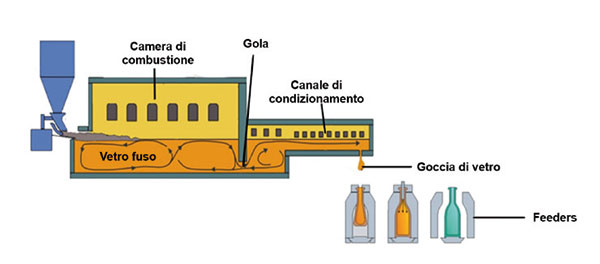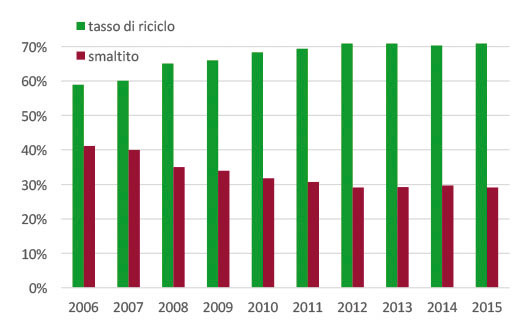Eco-efficiency of thin glass containers
Economic assessment of the sustainable production of glass containers shows that making the containers thinner and recycling them carries immediately quantifiable environmental advantages. The study was conducted by researchers at the Department of Management of the Sapienza University of Rome.
Andrea Esposito, Giuliana Vinci

In 2015, European glass production reached approximately 35 million t, putting Europe at the top of the ranking of global glass producers [1]. The glass industry comprises many sectors supplying various uses: 62% glass packaging (hollow glass); 30% plate glass (construction, automotive); 8% glass for other uses (chemical industry, pharma) [2].
Hollow glass leads global production thanks to characteristics that make it a suitable material for food packaging, in particular:
- sustainability (unlimited reusability and recyclability mean that it reduces raw materials and energy consumption);
- quality (it preserves the organoleptic properties of foods and is resistant to chemicals);
- health (it is unreactive and is easy to clean, sterilize and reuse);
- marketing (the possible shapes, colors and textures are limitless, conferring recognizability to popular and quality brands);
- versatility (it is used in myriad sectors, from food to pharmaceuticals and cosmetics).

1 - Diagram of melted glass passing through cooling tunnel.
Glass production
The glass production process begins with supply of the raw materials needed to form the mixture that can be turned into glass (table 1) [3]. Once dosed and mixed, the materials are fed into the melting furnace [4].
The melting furnace is made of refractory material that enables it to resist for years the high temperatures required for the melting process; it is heated through a series of openings on the walls of the furnace emitting methane-fed flames. The temperature can also be increased using electric devices (electrodes), which enable heating the glass more uniformly. The incandescent molten glass (approximately 1,200 degrees Celsius) is then poured into the mould of the forming machine (figure 1).
The molten glass is directed into the cast iron mould feeders through special guides, and then a combination of vacuum and compressed air forms the container. There are two main traditional processes for shaping glass containers: blow & blow and press & blow. Press & blow enables creating thinner and more lightweight containers. Forming is followed by annealing, i.e. reheating the container to remove stress from the glass. Finally the packaged containers are stored as finished products.

2 - Percentage of glass recycled in Italy (Source: CO.RE.VE., 2015).

Glass recycling
Glass can be melted and reshaped ad infinitum. This characteristic makes cullet (scrap glass) one of the most important ingredients in glass production [5].
In fact, some 60% of the raw material used to produce colored glass is derived from recycled cullet (recovered from public collection or scraps from factory processes)[6].
Cullet enables accelerating the melting process, and at lower temperatures, guaranteeing saving on raw material and energy.
In Europe, 75% of the glass consumed is recovered through separate collection, as much as 90% in Sweden, Switzerland, Austria, Belgium and the Netherlands, and 70% in Italy (under the European average).
Figure 2 shows the rate of recycling during the period 2006-2015. There is a clear positive growth trend [7].
In addition to an economic advantage, glass recycling also makes possible remarkable environmental advantages (table 2) [7].
The journey of recovered glass follows a precise logistical pathway, designed according to the location of production sites, that leads from the public glass collection container to storage warehouses where the glass is sorted by color and broken down.
The life cycle of packaging that is recycled is less than 30 days [8].

Thin glass and its advantages
Glass packaging has two criticalities: fragility and weight. Technological innovation has enabled overcoming these limits, at least in part, by making it possible to create increasingly thin and lightweight glass containers that maintain the functional properties of the traditional containers [9].
The techniques used to make containers thinner and lighter have been applied especially in the production of bottles for wine, spumante and champagne.
Over the last 20 years, many glass packaging manufacturers have implemented their own processes to obtain containers as much as 30-35% lighter. These results have been achieved through design and modeling techniques using narrow neck press and blow systems [8].
Table 3 compares the weights of a number of container types produced using different systems between 1990 (traditional techniques) and 2010 (narrow neck press and blow) [7].
The advantages of reducing the thickness and weight of glass containers can be measured in terms of two different timeframes: short and long term.
• In the short term, the main advantage relates to transport costs, since a thinner and more lightweight container enables a better use of space and higher loads on the means of transport [10].
• Over the long term, thinner and lighter glass containers prove more environmentally sustainable since they require lower melting temperatures, so less raw materials are consumed to generate the required energy. Recent studies have compared the carbon footprint of different container types (glass, plastic, metal, paper) by looking at the existing relationship between container production and CO2 emissions [11]. Such analyses have been developed through a “cradle to gate” methodology that evaluates all externalities of the finished product’s distribution.
Reduction of the thickness and weight of glass containers enables a 4-5% reduction in CO2 emissions.
Recycling and production of increasingly light and thin glass packaging carries substantial environmental advantages by saving on raw materials, energy recovery and lessening CO2 emissions, making such practices ecologically efficient and sustainable.
|
BIBLIOGRAFIA / BIBLIOGRAPHY 1) CONAI (2016). Imballaggio in cifre 2015. Consorzio nazionale imballaggi, Milano. 2) CO.RE.VE. (2016). Programma Specifico di Prevenzione 2015 (Risultati di Riciclo 2015). Consorzio Recupero Vetro. Milano. 3) ASSOVETRO (2015). Dati annuali del settore. Associazione nazionale degli Industriali del vetro. Roma. 4) Fernandes H.R., Tulyaganov D.U., Ferreira J.M.F. (2009). “Preparation and characterization of foams from sheet glass and fly ash using carbonates as foaming agents”. Ceram. Int., 35, 229-235. 5) Bernardo E., Cedro R., Florean M., Hreglich S. (2007). “Reutilization and stabilization of wastes by the production of glass foams”. Ceram. Int., 33, 963-968. 6) Bernardo E. (2007). “Micro- and macro-cellular sintered glass–ceramics from wastes”. J. Eur. Ceram. Soc., 27, 2415-2422. 7) CO.RE.VE. (2016). I benefici della raccolta-riciclo del vetro in Italia. Consorzio Recupero Vetro. Milano. 8) CONAI (2016). CONAI: il futuro della prevenzione? Verso l’eco-efficienza, con lo strumento “Life Cycle Assessment”. Consorzio nazionale imballaggi, Milano. 9) Accorsi R., Versari L., Manzini R. (2015). “Glass vs. plastic: life cycle assessment of extra-virgin olive oil bottles across global supply chains”. Sustainability, 7, 2818-2840. 10) Saner D., Walser T., Vadenbo C.O. (2012). “End-of-life and waste management in life cycle assessment”. Int. J. Life Cycle Assess., 17(4), 504-510. 11) Scotti M., Bondovalli C., Bodini A. (2009). “Ecological Footprint as a tool for local sustainability: the municipality of Piacenza (Italy) as a case study”. J. Environ. Impact Assess. Rev., 29, 39-50. |
Andrea Esposito, Giuliana Vinci Dipartimento di Management Sapienza Università di Roma, Via del Castro Laurenziano 9 00161 Rome

















